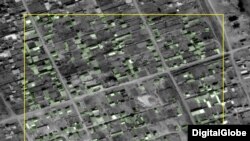Turkmenistan's government has gone to great expense to rebuild its capital and make it a beautiful, "white," city. But it is Ashgabat's residents who have paid the greatest price.
A new report from Amnesty International estimates that some 50,000 residents have been forcibly evicted from their homes as part of a campaign to "beautify" Ashgabat.
Focusing on an area it says was cleared out to make way for projects related to its hosting of the 2017 Asian Indoor and Martial Arts Games, the rights watchdog provides some startlingly ugly satellite images to show the lengths to which the city will go.
PHOTO GALLERY: The Clearance Of An Ashgabat Suburb
RFE/RL's Turkmen Service, known locally as Azatlyk, has been reporting about the home demolitions in and around Ashgabat for many years now, and I have mentioned it in Qishloq before.
The system works something like this: Residents are ordered to vacate their premises for the greater good. Knowing that others who suffered the same fate have rarely, if ever, received promised compensation, many disassemble their dwellings and take the material elsewhere to build a new home. It is the responsibility of former homeowners to find a place to build the new house. What's left in the neighborhood is demolished to make way for the promised urban-renewal projects.
At least, that's the plan.
The Ashgabat suburb of Choganly, the focus of the Amnesty report, once had nearly 13,000 homes, according to Azatlyk (Amnesty International said about 10,000). It was one of the areas targeted for a renewal project, and demolition work started about one year ago. Plans called for some 1,600 new cottages to be built.
But half a year after the last vestiges of habitation were removed there is no sign anything is being built. An Azatlyk correspondent has visited the site several times during the last year and reported all that was left six months ago were clay tandyr ovens for baking bread -- and those were quickly razed by bulldozers.
An Azatlyk correspondent recently visited Choganly and said there is nothing at the site except for a few trees, a bazaar, a bus terminal, and a taxi stand.
Amnesty International said "fresh demolitions are continuing in other areas of the capital rendering many families homeless."
Denis Krivosheev, Amnesty International's deputy program director for Europe and Central Asia, said in the report that "forced evictions can never be justified. Any eviction must always be a last resort and in compliance with international human rights standards." Krivosheev added that "this includes protecting the right to housing, ensuring compliance with appropriate legal and procedural safeguards and guaranteeing the right to oppose such evictions without fear and harassment."
Krivosheev also said that, "instead of using the games as an opportunity to clean up Turkmenistan's human rights record, local authorities there have only succeeded in worsening living conditions for residents, many of whom had moved to Ashgabat from the countryside in search of work or had already been evicted elsewhere."










